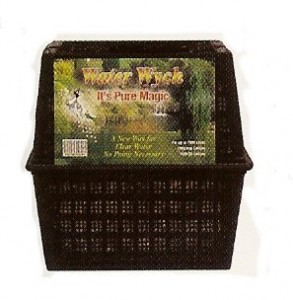 The Water Wych is a revolutionary new way to keep ponds clear and greatly reduce algae problems. Algae grows off of minerals and nutrients found in pond water. The Water Wych is a natural blend of volcanic rocks, carbons and silicates that absorb large amounts of nutrients and minerals from the water thereby greatly reducing the available "food" that algae needs to thrive. The Water Wych is a self-contained filter that simply sits submerged in the pond, for best results place in an area of flowing water. Once the organic materials in the Water Wych have absorbed all the minerals and nutrients they can, they can be used as fertilizer. Typically the Water Wych will need replacing every six to nine months. Water Wych is 100% organic - no chemicals! The Water Wych is available in four sizes for you to choose from, depending on the size of your water garden.
The Water Wych is a revolutionary new way to keep ponds clear and greatly reduce algae problems. Algae grows off of minerals and nutrients found in pond water. The Water Wych is a natural blend of volcanic rocks, carbons and silicates that absorb large amounts of nutrients and minerals from the water thereby greatly reducing the available "food" that algae needs to thrive. The Water Wych is a self-contained filter that simply sits submerged in the pond, for best results place in an area of flowing water. Once the organic materials in the Water Wych have absorbed all the minerals and nutrients they can, they can be used as fertilizer. Typically the Water Wych will need replacing every six to nine months. Water Wych is 100% organic - no chemicals! The Water Wych is available in four sizes for you to choose from, depending on the size of your water garden.
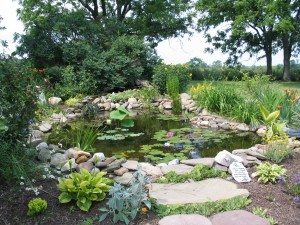 Adding beneficial bacteria is essential for the water garden and seeding of pond filters. Once established the bacteria lives by eating fish waste and other organic matter in the pond. Bacteria converts ammonia into nitrites which are then converted into nitrates. This process known as the Nitrogen Cycle is an important part of water maintenance. It is essential to the health of your pond inhabitants.
Adding beneficial bacteria is essential for the water garden and seeding of pond filters. Once established the bacteria lives by eating fish waste and other organic matter in the pond. Bacteria converts ammonia into nitrites which are then converted into nitrates. This process known as the Nitrogen Cycle is an important part of water maintenance. It is essential to the health of your pond inhabitants.
When cleaning your filter pads, lava rock or bio blox, care should be taken as to not kill the beneficial bacteria living there. Never use chlorinated water to clean filter pads, or if it is necessary to do so, try to stagger cleaning different pads at different intervals. Rinsing the filter media in a bucket of pond water will allow some of the bacteria to remain alive. We recommend adding beneficial bacteria after cleaning, and monthly to keep a thriving colony of bacteria in your filtration media. Bacteria is available in either liquid or dry.
Microbe-Lift makes a bacteria for each season. Each is formulated to work in the water temperatures of spring, summer and fall/winter. Microbe-Lift Spring/Summer Cleaner is a seasonal approach to the proper organic balance in your pond. It contains cool weather bacteria that will help to jump start your pond to a healthier environmentin the spring. Once the water temperatures have reached above 55 degrees, Microbe-Lift P/L (liquid bacteria cultures) or Microbe-Lift Tac (dry bacteria cultures) can be added. Both are specially formulated for water gardens to promote clean, clear pond water. Adding bacteria to your pond this season will significantly improve water quality and appearance.
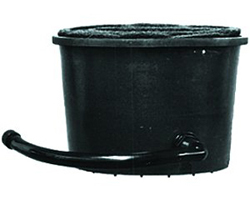 We've covered water temperatures, so what else should we do early spring prior to adding pond plants? We would like to mention a few things you should check when opening your pond for the season.
We've covered water temperatures, so what else should we do early spring prior to adding pond plants? We would like to mention a few things you should check when opening your pond for the season.
Check your pond to make sure there are no tears or leaks in your pond liner. Check around the edges of your pond to make certain the ground has not settled, and your pond is not leaking around the perimeter. Check out all your tubing, connections, pond pumps and filters to make sure they are all secure and working properly. If you have left your pump run throughout the winter make sure it is working properly. And for those who have turned off their pumps, you should check and clean them thoroughly. Turn your pump back on once the water temperatures are consistently above freezing which is around 40-45 degrees.
Remove any debris that has accumulated in your pond during the fall and winter. For those of you that have a pond vac, now is the best time to use those to rid your pond of small unwanted particles. You can begin putting MicrobeLift Spring and Summer in your pond to help with the cleanup. MicrobeLift Spring and Summer contains cold weather bacteria cultures that will work in the cooler water temperatures of spring. This will start establishing good bacteria and help accelerate the break down of debris. The spring rains help to flush your ponds, so if possible drain some of the water out of your pond and let the rain rinse and fill it up.
Once everything has been checked out you can begin thinking about feeding your fish, if you have them, and dividing some of the pond plants that have out grown their planting containers. We will discuss this in our next addition to Here Comes Spring.
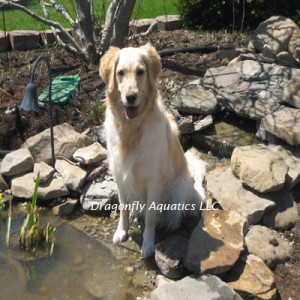 Time to spring forward, or at least turn the clocks forward! Things are beginning to warm up a bit here in the north and we are anxiously waiting for Spring to arrive so we can begin to add new plants to our ponds. Another couple of months and we will be sitting back enjoying our ponds once again. It won't be long now. For those in the warmer regions, zones 8 and above, you are putting pond plants in your ponds and starting to enjoy them, while those of us in the lower zones are still waiting. At least most of the ice has melted and we can begin thinking about our ponds once again.
Time to spring forward, or at least turn the clocks forward! Things are beginning to warm up a bit here in the north and we are anxiously waiting for Spring to arrive so we can begin to add new plants to our ponds. Another couple of months and we will be sitting back enjoying our ponds once again. It won't be long now. For those in the warmer regions, zones 8 and above, you are putting pond plants in your ponds and starting to enjoy them, while those of us in the lower zones are still waiting. At least most of the ice has melted and we can begin thinking about our ponds once again.
Don't be fooled by Mother Nature. We need to make sure it is warm enough outside, and make sure our pond water is warm enough for the plants to survive. Knowing your pond temperature is crucial, so begin by checking your pond water temperature at different times of the day. The pond water is cooler in the morning and warmer in the afternoon but will cool down again in the evening. Knowing what the consistant temperature of your pond water is important before adding the pond plants.
The first plants most of us want to put in are those that will help us keep the pond clear, such as floating plants like water hyacinths and water lettuce. Cold water will kill both of these in a matter of days if the water temperature is still too cold. We need to make sure the water temperature is consistent and reaches 65 degrees and stays there morning, afternoon and evening before we add floating plants.
There are other things we must do first that will keep us busy, such as adding beneficial bacteria to help keep our pond clear. The good bacteria, such as MicrobeLift PL neutralizes ammonia and nitrites, and will start to work when the water temperature are 50-55 degrees. If you add bacteria, it will stay in the pond and start working when the pond water is warm enough. It acts on its own and will stay un-activated until it knows to start working. For those of us who use barley, now is the right time to start adding it. This will also help retard the growth of string algae in the Spring months.
The list goes on and on. While all of us are anxious to add the pond plants there are still several things to do prior to this. I will be posting articles in the next few days with spring tips for our ponds.
Stay tuned!
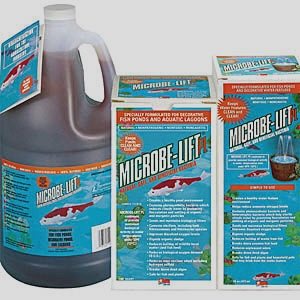 With March arriving, Old Man Winter should be packing his bags and moving on out! Those of us in the northeast, midwest and northwest can only hope that we have seen the worst of the 2009-2010 winter season. Those of you that live in the southern states are already able to get out and work on your ponds. Time to add Microbe-Lift Spring Summer cleaner if you have debris left from last fall and replace or clean your filter pads. Adding Microbe-Lift P/L when the water temperatures reach 50-55 degrees will also help seed your filter pads and improve water clarity. Meanwhile, those of us up north look out at our still snow covered ponds and hope things continue to melt, and Mother Nature is kind to us in the coming weeks.
With March arriving, Old Man Winter should be packing his bags and moving on out! Those of us in the northeast, midwest and northwest can only hope that we have seen the worst of the 2009-2010 winter season. Those of you that live in the southern states are already able to get out and work on your ponds. Time to add Microbe-Lift Spring Summer cleaner if you have debris left from last fall and replace or clean your filter pads. Adding Microbe-Lift P/L when the water temperatures reach 50-55 degrees will also help seed your filter pads and improve water clarity. Meanwhile, those of us up north look out at our still snow covered ponds and hope things continue to melt, and Mother Nature is kind to us in the coming weeks.
You'll find MicrobeLift Products here.
 Its essential to achieve a natural ecological balance in your pond. We can achieve this naturally with a few key steps. Adding submerged plants play an important role in achieving success by removing excessive nutrients in the water and provide oxygen during the day for fish and other aquatic creatures. The most important role is removing excessive nutrients that help reduce the incidence of algae which is the nightmare of most water gardeners. They starve out the algae by utilizing all the mineral salts which the algae normally feeds from.
Its essential to achieve a natural ecological balance in your pond. We can achieve this naturally with a few key steps. Adding submerged plants play an important role in achieving success by removing excessive nutrients in the water and provide oxygen during the day for fish and other aquatic creatures. The most important role is removing excessive nutrients that help reduce the incidence of algae which is the nightmare of most water gardeners. They starve out the algae by utilizing all the mineral salts which the algae normally feeds from.
Submerged pond plants oxygenate the water during the day, but at night the process is reversed and carbon dioxide is produced. This only becomes a problem if your night time temperatures are quite warm and you overstock your pond with fish. Generally the more submerged plants you put in your pond the better the pond balance will be.
Algae likes full sunlight so in addition to the submerged plants add floating plants, waterlily foliage or bog plants to cover at least one third to one half of your pond's surface, but no more than one half to be successful in controlling the green suspended algae.
There is a balance to achieve so make sure you don't cover too much of your ponds surface with plants or it will inhibit the submerged plants from growing.
The recommendation is to have 1 bunch of submerged plants per every 2 to 3 square feet of surface area. We sell submerged plants by the bunch so you receive 6-8 plants per bunch. You can determine your surface area by multiplying your length by the width of your pond. This gives you a general idea.
A similar calculation is made to determine the quantity of floating plants and waterlilies for your pond. Determine the square footage and remember you don't want more than half of the surface covered so that the submerged plants receive plenty of light.
Once you create the formula for water clarity the rest is easy.
 Microbe-Lift PL is specially formulated for decorative fish ponds, lagoons and smaller water features. Adding bacteria to your pond is important. It creates a healthy environment for your pond, promoting faster fish growth. Microbe-Lift PL also reduces ammonia nitrogen levels, dissolves away organic sludge, improves dissolved oxygen levels and helps break down dead algae. Adding Microbe-Lift PL on a regular basis will seed and maintain biological filters. Bacteria contains photosynthetic bacteria which helps eliminate cloudy water by promoting flocculation and settling of organic and inorganic particles.
Microbe-Lift PL is specially formulated for decorative fish ponds, lagoons and smaller water features. Adding bacteria to your pond is important. It creates a healthy environment for your pond, promoting faster fish growth. Microbe-Lift PL also reduces ammonia nitrogen levels, dissolves away organic sludge, improves dissolved oxygen levels and helps break down dead algae. Adding Microbe-Lift PL on a regular basis will seed and maintain biological filters. Bacteria contains photosynthetic bacteria which helps eliminate cloudy water by promoting flocculation and settling of organic and inorganic particles.
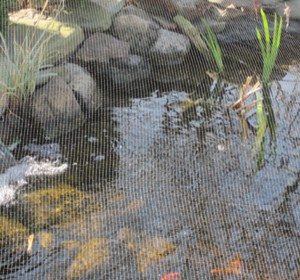 I hope everyone enjoyed their Thanksgiving with family and friends, and of course, a delicious meal.
I hope everyone enjoyed their Thanksgiving with family and friends, and of course, a delicious meal.
I finally put all my plants to bed for the winter and covered the pond. It looks bare, but the fish all seem happy, even with the cooler water. It has been a long fall, so we have been lucky so far. Normally this time of year, we have already had our first snow and temperatures well below 40 degrees. Daytime temperatures have been averaging around 45 degrees to 55 degrees, with a bit more sun then Ohio usually sees, this time of year. Lucky so far, but what will winter bring.....
A couple of weeks ago, I noticed I had a few lilies starting to get green, Aquatic For-Get-Me Nots still blooming and Cannas that refuse to die back so I can store them for the winter......they all must be a bit confused. Snow and more seasonable temperatures are forecast for the end of this week, that should send the rest of the plants, that have been hanging on into dormancy.
I read an interesting article about algae that I thought I'd share. It mentioned putting barley straw in your pond during the winter to help control algae. I put a couple barley bundles in my pond, to see if it makes a difference in the spring. Water gardeners will do almost anything to keep that nasty algae from growing. As soon as temperatures begin to warm in the spring, before the water lilies send up their first few leaves, the algae seems to re-appear on the waterfalls, sides of the pond and in the stream beds. Barley does not kill algae, it prohibits it from growing. From everything I have read, and talking to customers that use either the barley bundles, barley extract or barley straw pellets, it does the trick! Next spring....hopefully no more algae!
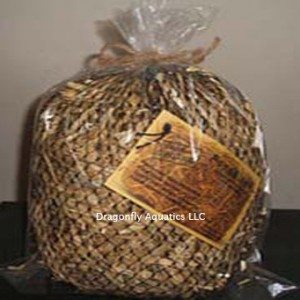 As water temperatures cool, algaecides such as PondCare Algaefix, Microbe-Lift Algaeway and Green Clean are less effective. Adding Microbe-Lift Barley Straw Extract or Barley Straw Bundle will help control string algae throughout the fall and winter months. Microbe-Lift Barley Straw Extract, Microbe-Lift Barley Straw Pellets or Barley Straw bundles are an effective and eco-friendly way to reduce algae.
As water temperatures cool, algaecides such as PondCare Algaefix, Microbe-Lift Algaeway and Green Clean are less effective. Adding Microbe-Lift Barley Straw Extract or Barley Straw Bundle will help control string algae throughout the fall and winter months. Microbe-Lift Barley Straw Extract, Microbe-Lift Barley Straw Pellets or Barley Straw bundles are an effective and eco-friendly way to reduce algae.
Purchase MicrobeLift Barley Straw, Barley Bundles, Barley Pellets here.
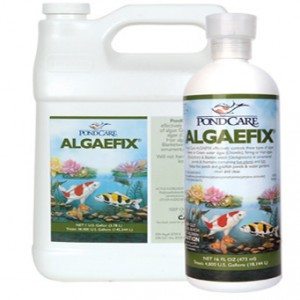 One plague of summer can frustrate even the most diligent pond keeper - ALGAE. Best known as long stringy algae to those who have suffered its presence in their ponds, this noxious form of algae thrives in the warm water full of nutrients that receives even modest amounts of sunlight. Although algae is common to aquatic habitats, natural ponds do not have this particular form unless significant environmental problems exist, such as run-off containing fertilizers entering a pond.
One plague of summer can frustrate even the most diligent pond keeper - ALGAE. Best known as long stringy algae to those who have suffered its presence in their ponds, this noxious form of algae thrives in the warm water full of nutrients that receives even modest amounts of sunlight. Although algae is common to aquatic habitats, natural ponds do not have this particular form unless significant environmental problems exist, such as run-off containing fertilizers entering a pond.
Usually the typical fishpond that has high nutrients you can count on long stringy algae to show up each summer, and the worse the nutrient problem, the sooner it will appear. Having lots of fast growing plants helps combat this algae problem, but they can take up so much of the ammonia and nitrate available.
Remove as much long stringy algae as possible. It's much much fun - truth be told. This messy, unpleasant task has to be done. It would be better if you had managed the pond in the spring, the perfect time to create a healthy aquatic environment for the fish during the summertime. Once you have removed as much string algae as possible treat the pond with Green Clean, Algae Fix (by Pond Care) or Algaway (by MicrobeLift). Both Algae Fix and Algaway are similar but I tend to stick with all MicrobeLift Products since I know they have proven safe in my pond. Pond Care Algae Fix is highly recommended by alot of pond owners. The GreenClean works great also. See the article on Green Clean. After you treat your pond with the algae product next you would want to add MicrobeLift PL , active bacteria, which will help accelerate the decomposition of the dead algae so it will filter out. Once you have the algae under control you can add a weekly dose to maintain.
Having at least half the surface area covered with plants like water lilies, lotus and floating plants will help protect your water garden from summer-thriving algae by competing with it for nutrients. Floating plants and submerged plants help combat this evil menace of the water gardener.
The main goal is to try and prevent algae from growing. Aim to achieve a natural ecological balance in your pond, add more plants, and don't overstock with fish.